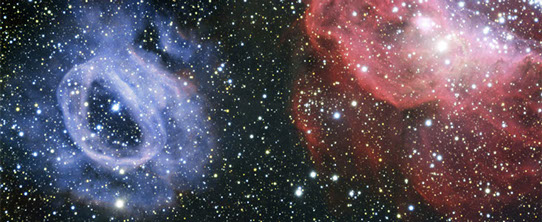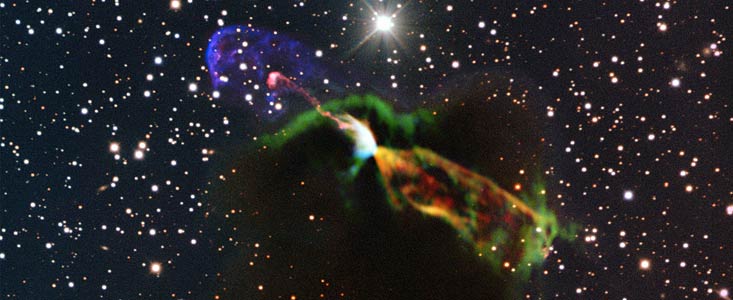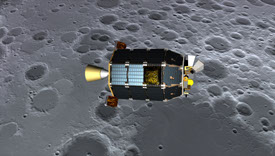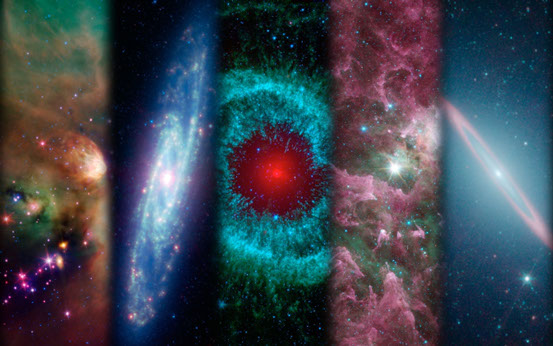



September 2013
Black Hole in M87
The Hubble Space Telescope has been observing a black hole at the center of galaxy M87. Astronomers have taken images over a 13 year span and put them together in a 'time-lapse' image and video. The images show a jet of superheated gas 5,000 light years long being ejected from the black hole.
It is believed that all galaxies have supermassive black holes that have gone through an active stage. By studying these, we can learn more about galaxy formation and evolution, as well as black hole physics.
The M87 observations indicate that the jet's spiral motion is created by a helix-shaped magnetic field that surrounds the black hole. The gases appear to zig-zag, which would indicate it is moving along a spiral path. This gas appears to loop around an invisible structure.
Evidence that the jets behave with a ballistic effect in some cases and as a magnetically driven shock in others has been found. Some objects move very quickly, other slowly and still others appear stationary. These gases of hot plasma are therefore very dynamic.
Astronomers plan to study more black holes in this manner to see if this one in M87 is unique or if most or all black holes behave in this manner.
M87 is located in the Virgo cluster containing around 2,000 galaxies located 50 million light-years away. The black hole in M87 is several billion times more massive than our sun.

IMAGE CREDIT: NASA, ESA, E. Meyer, W. Sparks, J. Biretta, J. Anderson, S.T. Sohn, and R. van der Marel (STScI), C. Norman (Johns Hopkins University), and M. Nakamura (Academia Sinica)
Large Magellanic Cloud
The Very Large Telescope at ESO's Paranal Observatory in Chile has taken this photo of two neighboring star-forming regions in the Large Magellanic Cloud. Nebula NGC 2014 is red in color and NGC 2020 is blue. Powerful stellar winds form extremely hot newborn stars radiate into the gases making them glow brightly.
NGC 2014 glows red-ish in color. It is a cloud of mostly hydrogen gas and contains a cluster of young hot stars. The red glow is caused by the hydrogen gas being ionized. The radiation from these newly forming stars strips electrons from the atoms of the hydrogen gas, ionizing it.
NGC 2020 glows blue-ish in color. The same process of ionization is taking place here also, but in this case the gas being ionized is oxygen instead of hydrogen, producing a blue color instead of red.
The brilliant star in the center halo of NGC 2020 is producing powerful stellar winds that is causing the gas to disperse and stream away. The star has produced a cavity or bubble-like look. This star is a rare class of stars called Wolf-Rayet stars. They are short-lived stars that are very hot, exceeding ten times the temperature of our sun.
The Large Magellanic Cloud is only 163,000 light years from our galaxy. Astronomers call it an irregular dwarf galaxy or a companion galaxy to the Milky Way. It is believed the Large Magellanic Cloud, the Small Magellanic Cloud and the Milky Way had interactions with each other in the past. The Large Magellanic Cloud and the Small Magellanic Cloud are easily visible with the naked eye in the Southern Hemisphere and were named after Ferdinand Magellan in the 1500's. Both contain extremely active areas of star formation.

Visit our sponsors.
For advertising opportunities on this page and our videos, contact
Upcoming Launches
Date: September 6
Launch Vehicle: Minotaur V
Launch Site: Wallops Flight Facility, Wallops, VA
Description: LADEE will gather information about the atmosphere of the moon.
Date: September 17
Launch Vehicle: Antares
Launch Site: Wallops Flight Facility, Wallops, VA
Description: Orbital Sciences will launch a demonstration mission to the ISS, testing the Cygnus cargo vehicle.
Date: September 25
Launch Vehicle: Soyuz 36
Launch Site: Bailkonur Cosmodrome, Kazakhstan
Description: Soyuz 36 will carry three Expedition 37/38 crew members to the ISS.
Image Credit: ESO
Herbig-Haro 46/47
The Atacama Large Millimeter/submillimeter Array (ALMA) in Chile has taken a close-up look at an object called Herbig-Haro 46/47. This is an object containing a newborn star.
Radiation ejected from the newborn star interact with the gases creating the glow. At Herbig-Haro 46/47, jets of material are being blown out into interstellar space at speeds as high as a million kilometers per hour. ALMA has provided unprecedented sharp images allowing astronomers to determine the ejected material velocities are much faster that previously believed.
This system is similar to most stars formation and birth. But in Herbig-Haro 46/47, there is also an unusual phenomenon going on. The outflow impacts the cloud directly on one side of the star and escapes out the other. This is caused by the stellar winds originating from another object, a lower mass companion.
Herbig-Haro 46/47 is about 1400 light years from earth and located in the constellation Vela in the Southern Hemisphere.

Image Credit: ESO
LADEE
The Lunar Atmosphere and Dust Environment Explorer (LADEE) is set to lift off Friday September 6th from NASA's Wallops Flight Facility on Wallops Island, VA aboard a Minotaur V rocket. LADEE is the first spacecraft designed in the Bus architecture which is designed to incorporate a system allowing NASA to build, test and assemble multiple modules at the same time. The same common bus can be used for different missions making it a multi-use system.
When arriving at the moon, LADEE will begin a 40 day commissioning phase where it will be in high lunar orbit. Activities will include testing a high-data-rate laser communication system. After commissioning, LADEE will begin a 100 day science mission to collect data about the moon. Three instruments will determine the composition of the the thin lunar atmosphere and remotely sense lofted dust, measure variations in the chemical composition of the atmosphere, and collect and analyze samples of lunar dust particles in the atmosphere. Scientists hope to answer the question if lunar dust, electrically charged by the sunlight, was responsible for the pre-sunrise glow above the lunar horizon witnessed by the Apollo astronauts on several missions. 
The results will also help scientists understand other objects with similar characteristics such as large asteroids, Mercury and the moons of the outer planets.
Image Credit:NASA Ames/Dana Berry
Spitzer
NASA's twin Van Allen Probes have discovered a particle accelerator at the heart of the Van Spitzer turns 10! NASA's Spitzer Space Telescope marked 10 years studying the cosmos in the Infrared.
Spitzer has made numerous discoveries and performed observations of both the near and far universe. When comet Tempel 1 was hit by NASA's Deep Impact mission in 2005, Spitzer studied the composition of the comet, revealing it resembled that of solar systems beyond our own.
Spitzer discovered an enormous ring of Saturn, a wispy band of ice and dust too faint for visible light. Spitzer was able to see it in the infrared.
Spitzer was the first to detect light coming from a planet outside our solar system. By looking at the exo-planets in the infrared, Spitzer is able to help unlock their composition, dynamics and more.
Spitzer has also studied new stars being formed in nearby clouds to mapping the spiral-arm of the Milky Way to discovering the most distant galaxies are more massive and mature than previously thought.
In October, Spitzer will set its sights on an asteroid named 2009 DB. Spitzer will help scientists determine the asteroid's size and evaluate the asteroid as a potential candidate for Nasa's asteroid capture and redirection mission.
Spitzer ran out of coolant for its longer-wavelength instruments in 2009, but is still able to provide incredible science in it "warm-phase". The journey continues.

Image: Montage of Spitzer photos - the universe in infrared.
Image Credit: NASA/JPL-CalTech
Kepler
NASA has ended its attempt to get the wheels of the Kepler Space Telescope operational. Two of the four wheels have failed. The wheels are what align the telescope for observing. This renders the spacecraft unable to do any fine precision aiming and may point to the end of the Kepler mission. Kepler was designed to hunt for planets outside our solar system.
To date, Kepler has discovered 136 confirmed planets. It has also found 3,548 candidates that may be planets and another 2,165 eclipsing binary stars that may be evidence of planets.
Kepler was able to determine planetary characteristics such as mass, radius, density and temperature. It measured the orbit including period, eccentricity, inclination, duration and semi-major axis.
Kepler discovered planets by measuring the brightness of stars. When a planet passed in front of the star, its brightness went down. Once a planet is detected, Kepler could measure the time it passed in front of the star again and then determine its mass using Kepler's Third Law of planetary motion (developed by Johannes Kepler whom the telescope was named after). The size of the planet could then be determined along with the other planetary characteristics. From the characteristics, one can then determine if the planet might be habitable.
© 2014-2016 Ted Cook Productions LLC. - All Rights Reserved